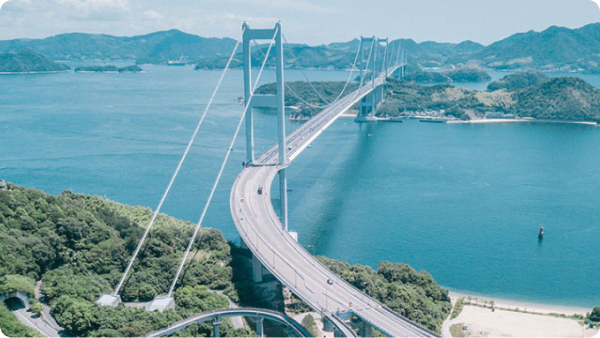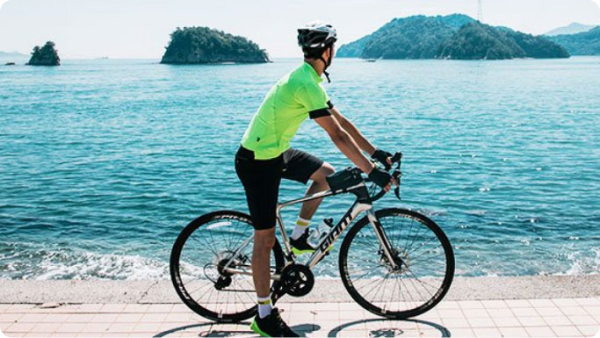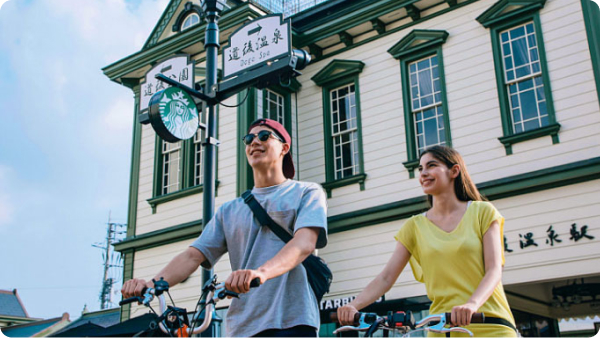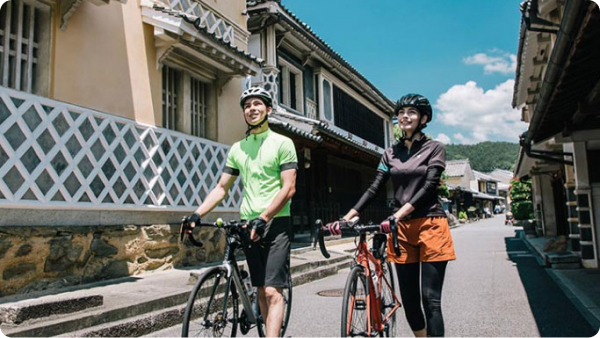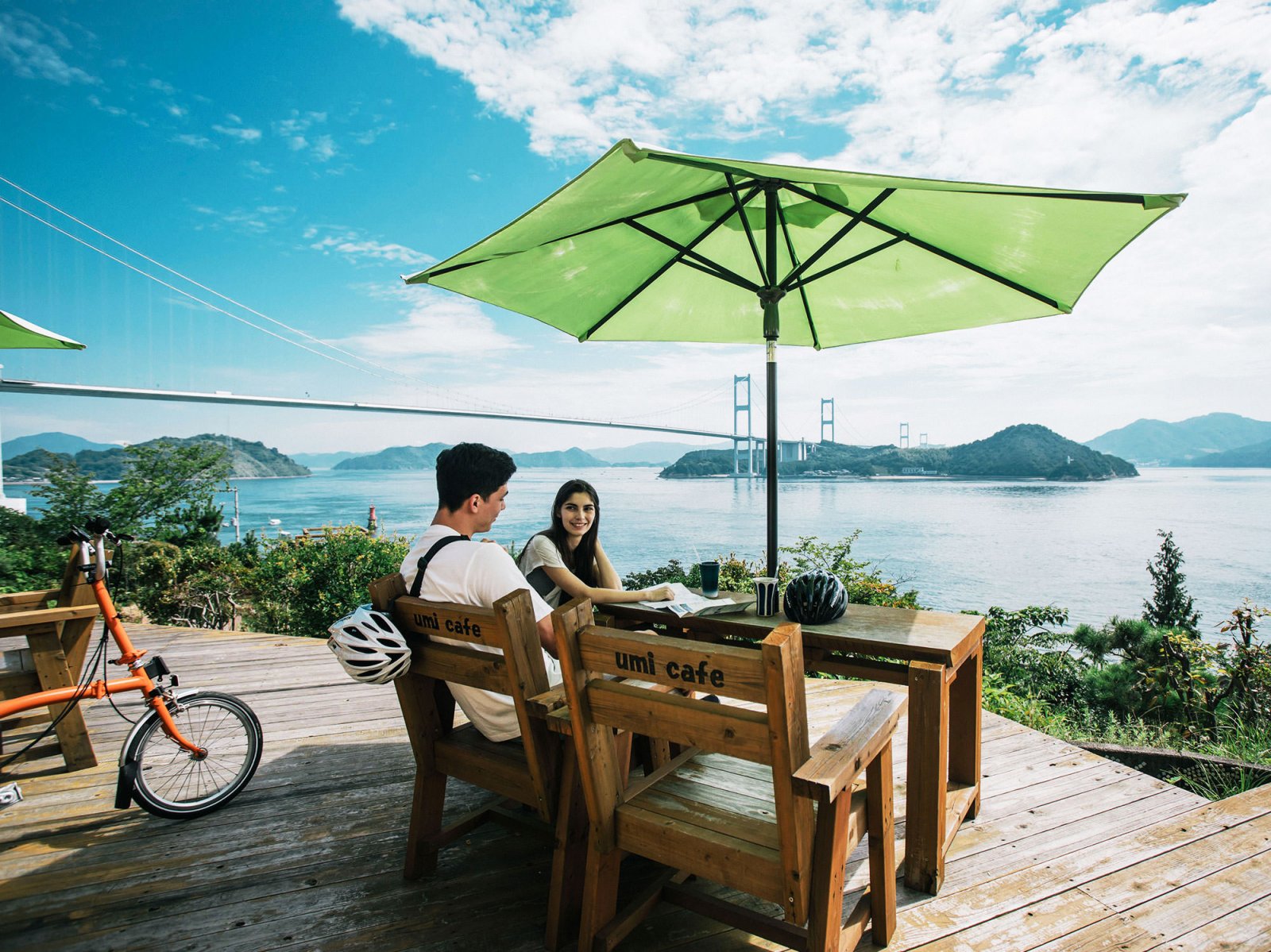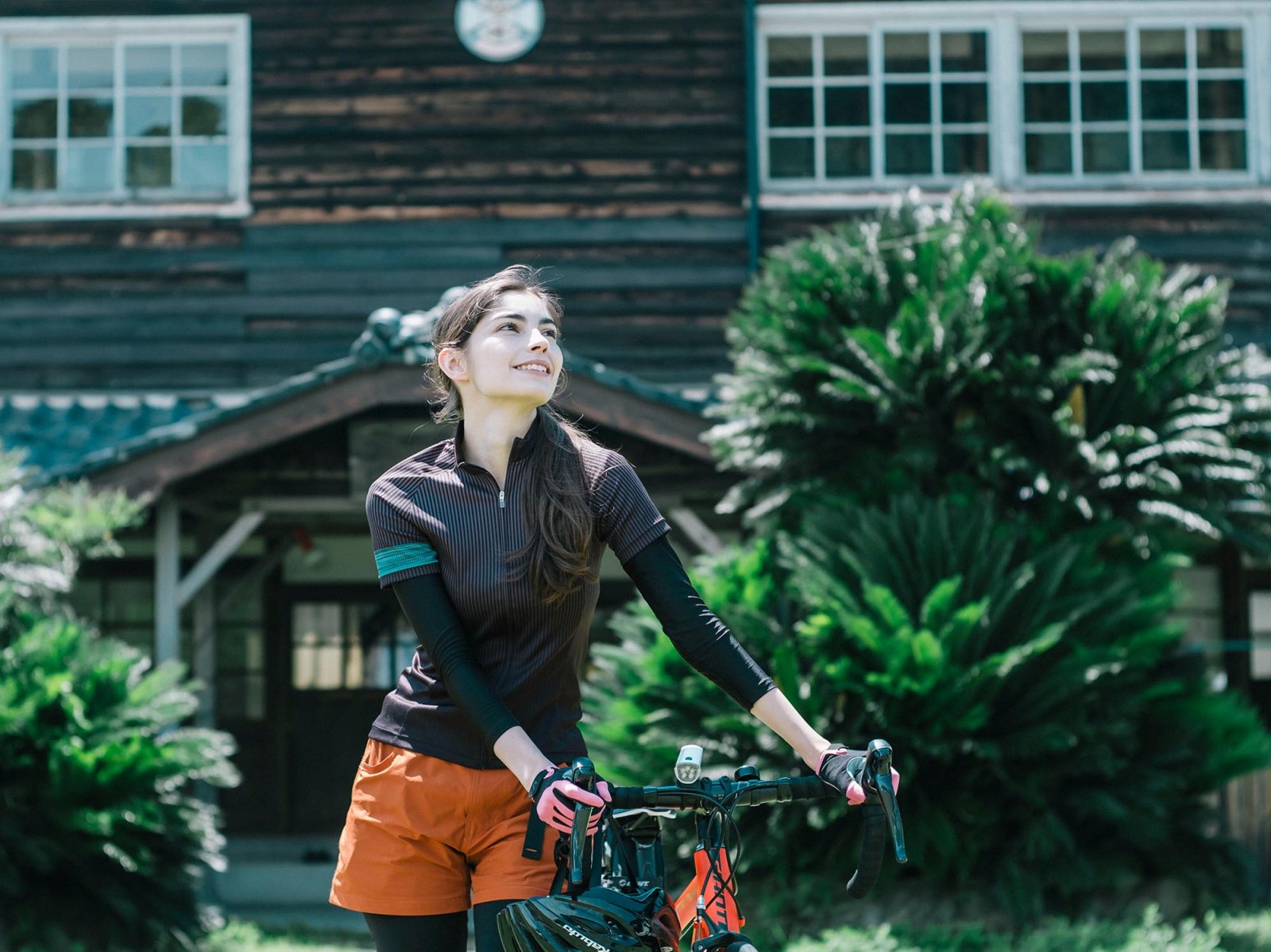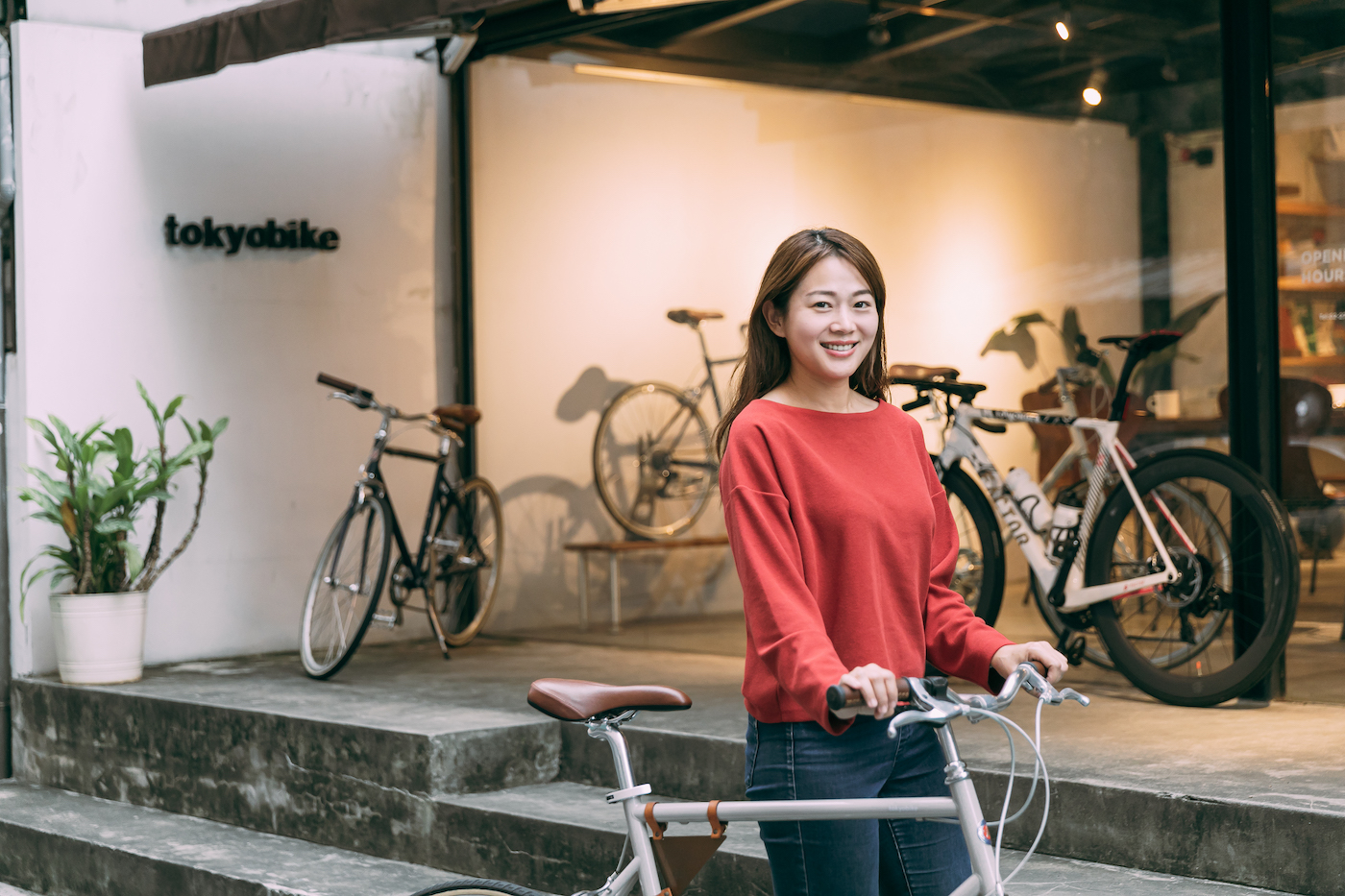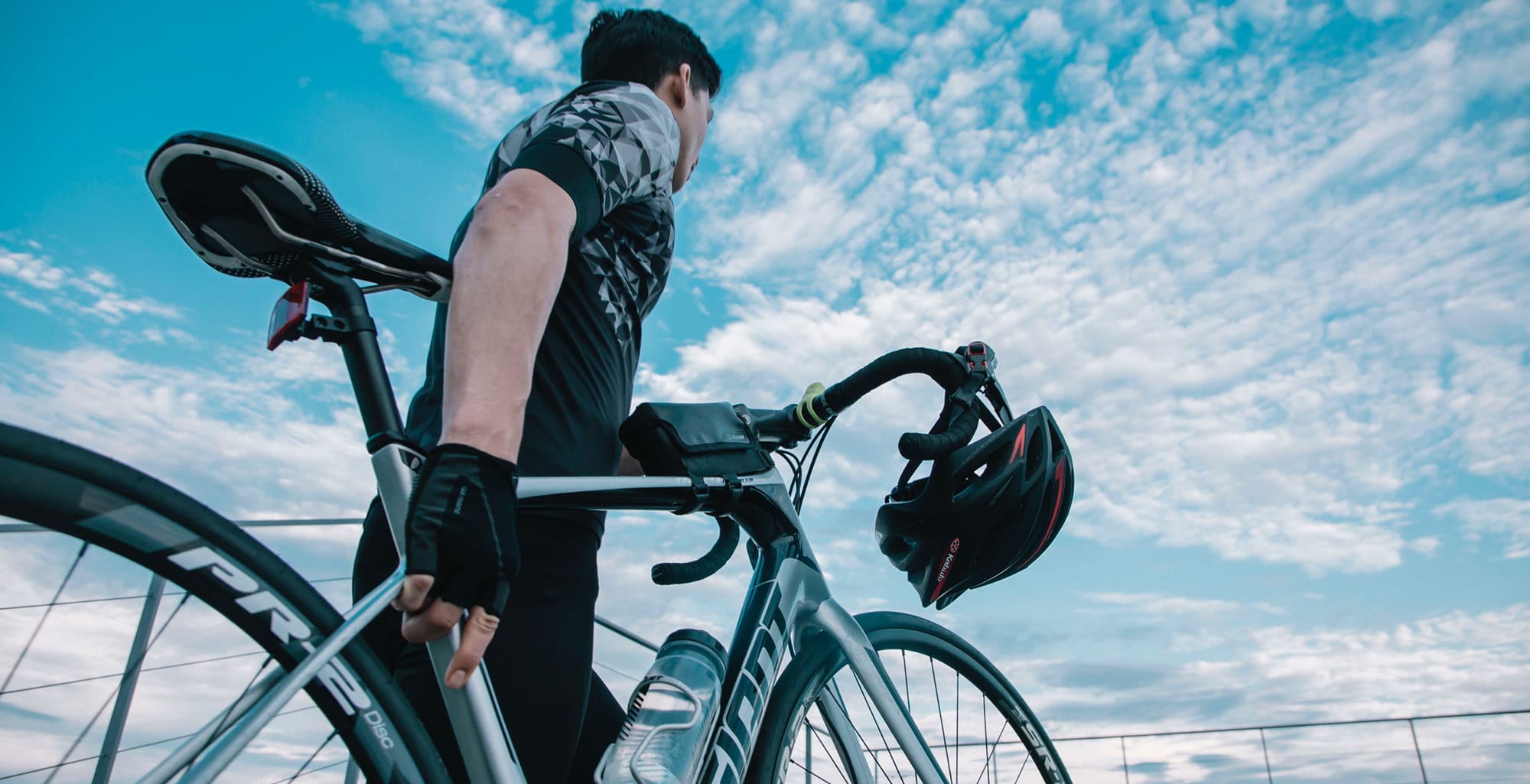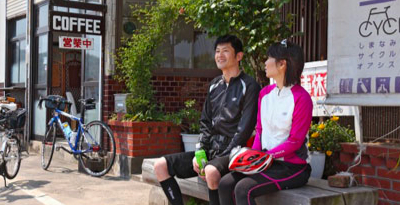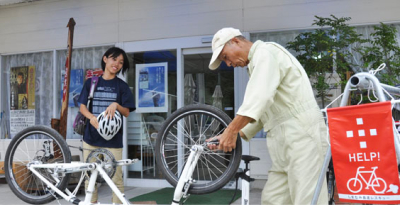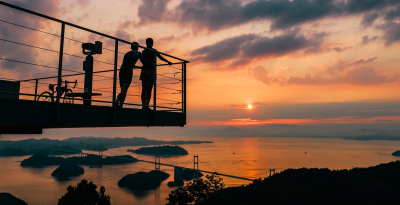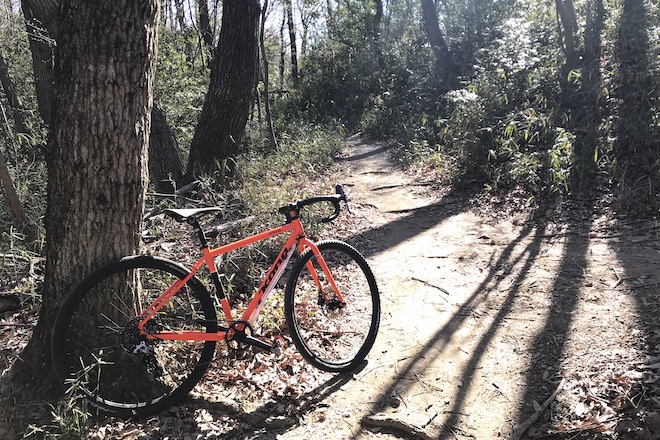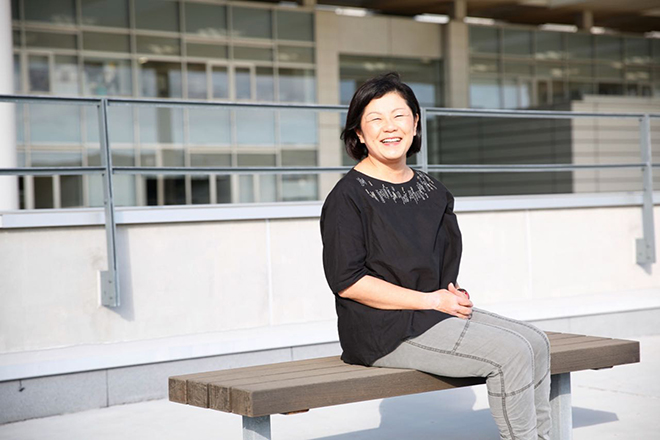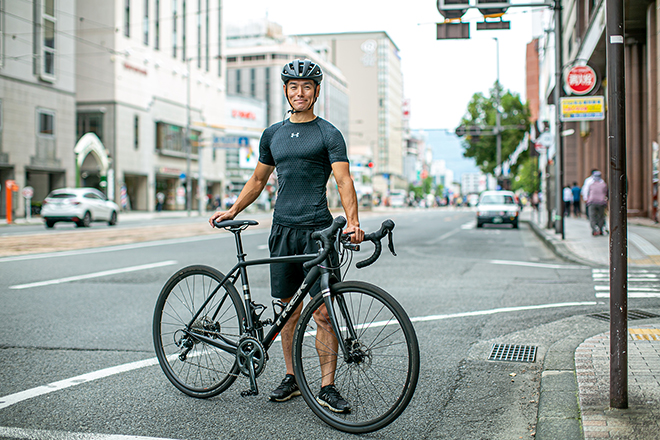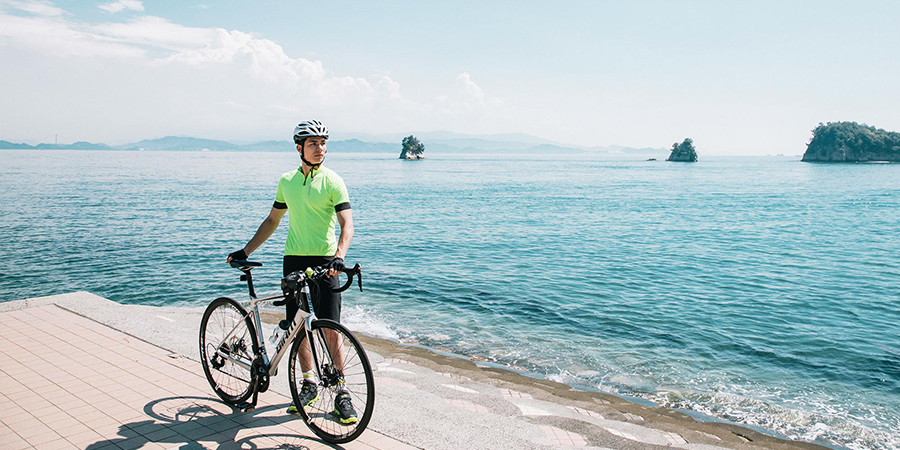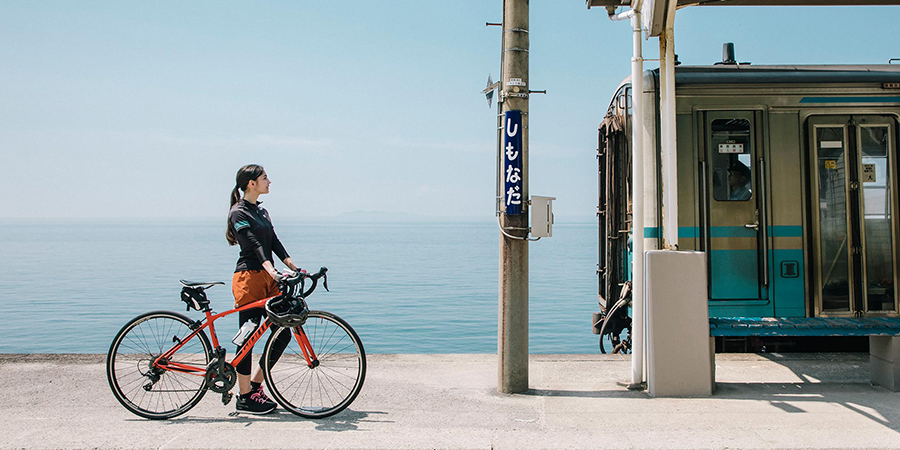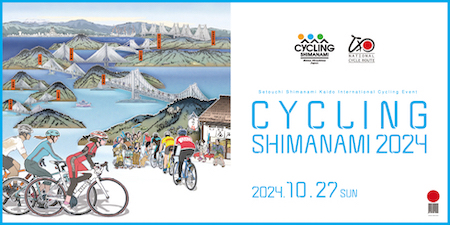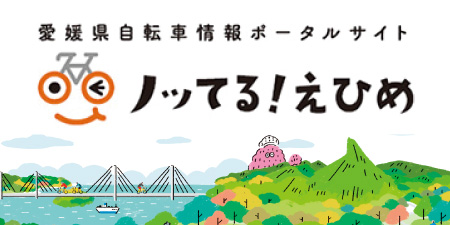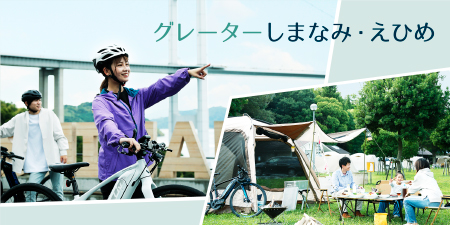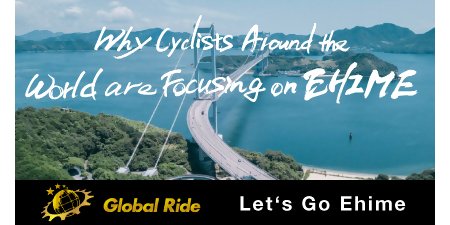Cycling the Shimanami Kaido—Tips from a cyclist with a decade of local guiding experience
Cycling the Shimanami Kaido—Tips from a cyclist with a decade of local guiding experience

The Shimanami Kaido cycling road runs between Onomichi City in Hiroshima Prefecture and Imabari City in Ehime Prefecture, roaming over six bridge-linked islands in the Seto Inland Sea. Winning a name for itself with its picturesque archipelago scenery, gourmet cuisine, and well-maintained path, it’s a holy grail for cycling enthusiasts, selected by America’s CNN travel information website as one of the “Seven Best Bike Routes in the World.”
However, when it comes to actually visiting, there are no doubt many things you would like to know in advance, such as what level of cycling ability you need to finish the trail and which spots are not to be missed.
That’s why we talked to Kazunari Utsunomiya, who has worked as a Shimanami Kaido guide for over 10 years and is involved in developing the cycling trip itineraries. We asked him for tips on completing the Seto Inland Sea crossing and where we should stop off on the way.
Spread your ride over a few days to enjoy the gourmet cuisine and sublime scenery
– Even at its shortest, the Shimanami Kaido is 70 to 80 km long, and it contains hilly patches such as bridge approaches and mountain passes. What level of cyclist do you need to be to finish the course?
Utsunomiya: Anyone can do it. Blue lines painted on the road and plenty of roadside signage make the course easy to follow for people who are new to cycling routes. This route alone offers ample highlights on the way, but experienced cyclists or repeaters can try departing from the route a little to discover different kinds of scenery.
History, scenery, cuisine—there are truly a huge variety of enjoyments packed into the Shimanami Kaido. But the most important thing is the cyclist’s perspective what it is they want to enjoy.
I recommend a leisurely itinerary that spaces the ride out over two or more days and lets you spend a night or two on an island here or there, giving yourself time to enjoy the gourmet cuisine and breathtaking scenery. If you’re going one way, I think even a weekend would be long enough to enjoy yourself.
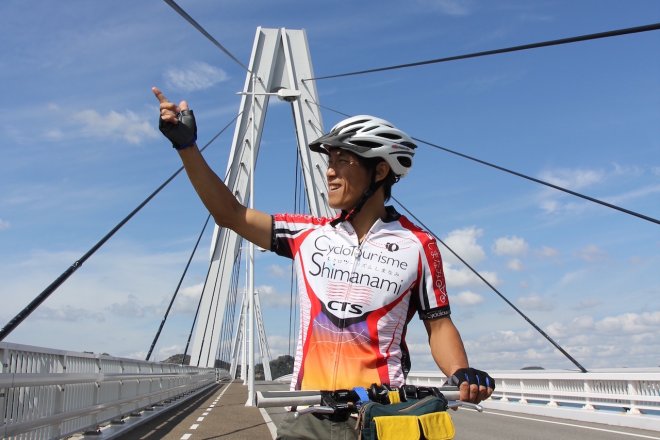
Kazunari Utsunomiya
– Some people don’t have their own bicycle, or they can’t bring it with them. If it’s a one-way journey, can they drop off a rental bicycle at a different location?
Utsunomiya: If you use the publicly-operated Shimanami Rental Cycle, you can rent a bicycle at either the Ehime or the Hiroshima end, and return it at one of the rental cycle terminals dotted along the route. There are several rental cycle services operated in tourist areas around Japan, but I don’t believe there are any that offer a comparable service.
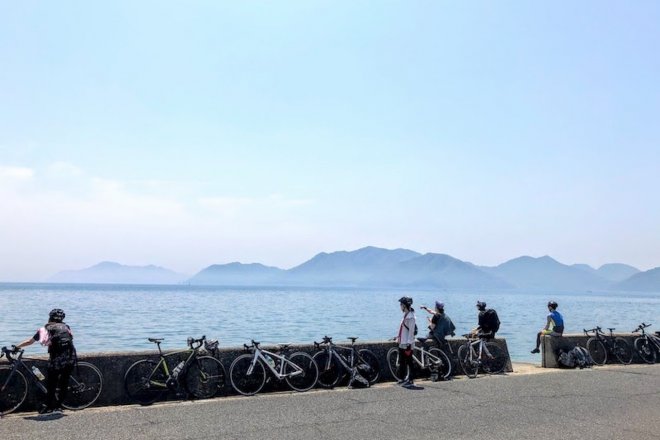
Breathtaking vistas as far as the eye can see (Photograph: Moyuru Matsuda)
Spare a thought for your bottom before you depart!
– Is there anything we should prepare before setting out to cycle?
Utsunomiya: One thing I hear all the time is the complaint of sore bottoms on long distance rides. It’s a shame to have the motivation, but have to give up just for that reason. Measures you can take include wearing padded cycling shorts or fitting a gel saddle cover to absorb the impact to your buttocks.
Another thing that really weighs cyclists down is carrying too much luggage. As long as you have clothing that allows movement and the bare essentials (such as a toothbrush) for staying overnight somewhere, you can shop at places like convenience stores on the way. It’s important to have an “I’ll get by without it” kind of mindset. If you are using your own bicycle, it’s helpful to bring your wheel bag(s) so that you can load your bike onto a bus or train if it becomes necessary.
The six islands are a treasure trove of local delicacies and sweets
– We’d like to give readers an itinerary for the Onomichi–Imabari course. Do you have a plan suited to the kind of person who rides around two or three times a week, or has built up fitness through playing a sport regularly?
Utsunomiya: Onomichi is easily accessible from Tokyo, Kyoto and Osaka via overland routes using the shinkansen and JR trains. Where possible, it’s best to plan to spend the night before in Onomichi or arrive in the morning, so that you can take your time on your ride.
Depending on your fitness level, you can plan all kinds of rides, including cycling the outer circumference of the islands, or crossing to other islands in the vicinity, such as the Tobishima Kaido route, but here I’ll outline the standard course.

Bridges, bridges, and more bridges on the Shimanami Kaido
– Thank you! I’d also appreciate some info about sightseeing spots and gourmet cuisine to enjoy alongside our cycling.
Utsunomiya: The first tip is to travel to Mukaishima, the first island, by the bicycle-friendly ferry instead of riding over the bridge. The bridge is located at some distance from Onomichi Station, whereas the ferry departs from a point nearby and takes only five minutes to make the crossing.
On Mukaishima, you’ll find Goto Kosensho, a beverage manufacturer established in 1930, where they manufacture and sell soda and juice bottled in glass. It’s customary to wet your whistle here and then move on and eat hassaku daifuku, a pounded rice sweet containing locally grown hassaku oranges, at Innoshima, the next island on the trail.
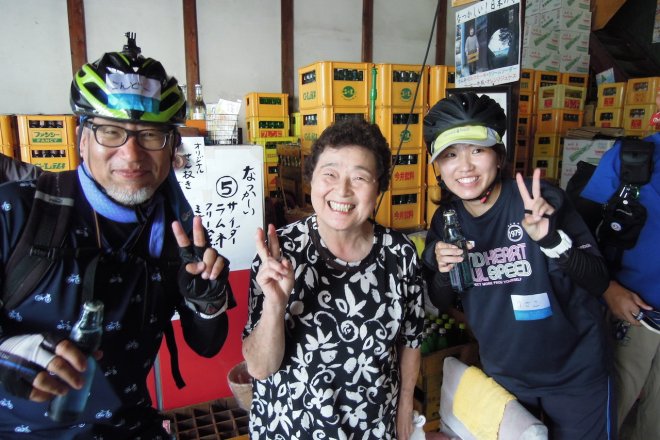
A warm smile from the friendly owner of Goto Kosensho will brighten up your day
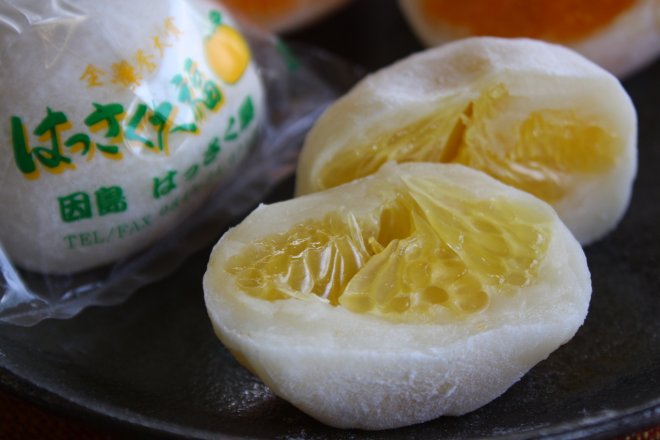
Hassaku orange daifuku from Hassaku-ya
Utsunomiya: The next island is Ikuchijima, where Dolce, a gelato specialty store, and Chidori noted for its takotendon-tamagotoji (octopus tempura in softly scrambled egg on rice) have made a name for themselves. There are numerous attractions here including the Island-Wide Art Museum which features 17 art works dotted here and there around the island, and the Kosanji Temple complex lined with temple buildings modeled after Shinto and Buddhist architecture from all over Japan.

Kosanji
Hot springs, seafood, and craft beer—Stay overnight and unwind in Omishima
– There sure are a lot of places worth a visit! Where should we aim to finish up on the first day?
Utsunomiya: For a place to stay, I recommend Omishima, the island after Ikuchijima. It’s around about the middle of the Shimanami Kaido, and the first island that’s part of Ehime, so I think you’ll feel a sense of achievement when you arrive.
On Omishima, the blue line for novice riders tracks a course along the east coast heading south. If you’re a slightly stronger rider, how about heading over the mountains to the Miyaura region on the west side of the island. There are a wealth of attractions here, including the Mare Gracia Omishima, a hot spring popular for its open-air bath that looks out over the Seto Inland Sea, and Oyamazumi Shrine, Shimanami’s foremost sightseeing spot. I also recommend a visit to the microbrewery and beer cafe, Omishima Brewery.
One thing that goes for the entire Shimanami Kaido is that the seafood served up is undeniably delicious! I hope you’ll try the fresh ocean bounty at restaurants and places you stay.
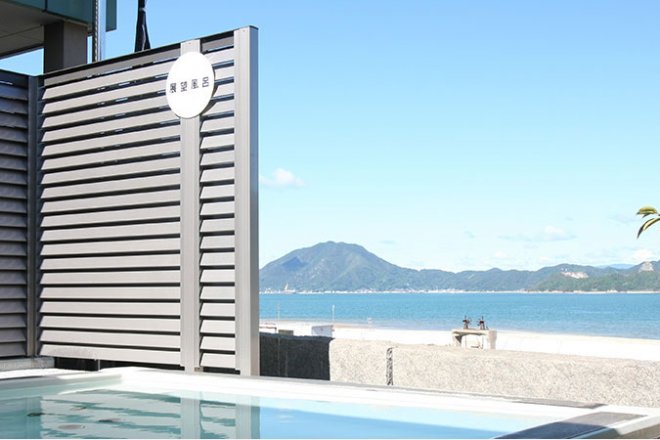
Mare Grassia Omishima
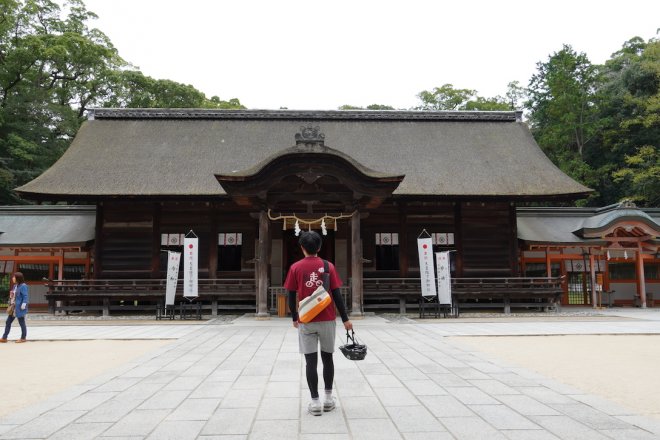
Oyamazumi Shrine
– Hot springs, beer and seafood dishes—that will really hit the spot for a tired body after a day of cycling!
Utsunomiya: That’s right. It’s a journey, so detours are definitely important. If you have any leftover energy on Omishima, you can ride along the north side and feast your eyes on the ocean for truly exhilarating cycling. The south side is for seasoned cyclists, but this route also offers breathtaking scenery rich in nature. As a matter of fact, sticking to the blue line will mean very little cycling on coastal roads, no matter which island you are on. Detours are the best bit of a cycling journey, don’t you think?
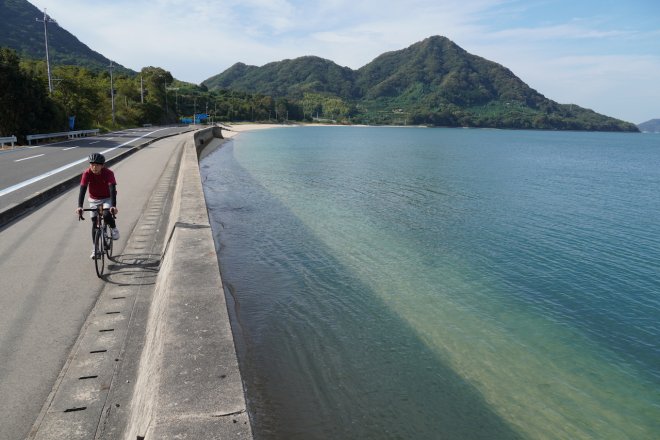
A route offering views of the ocean on the north side of Omishima
Veer off the blue line to experience the best of the Shimanami Kaido
Utsunomiya: The next island is Hakatajima, known for Hakata Salt, the famous brand you’ll often find in supermarkets. Following the blue line on this island will have you on the next bridge in a short 3 km or so. You might want to stop at the Marine Oasis Hakata inside the Hakata SC Park roadside station on your way through and treat yourself to salt-flavored ramen noodles and salt-flavored soft-serve ice cream.
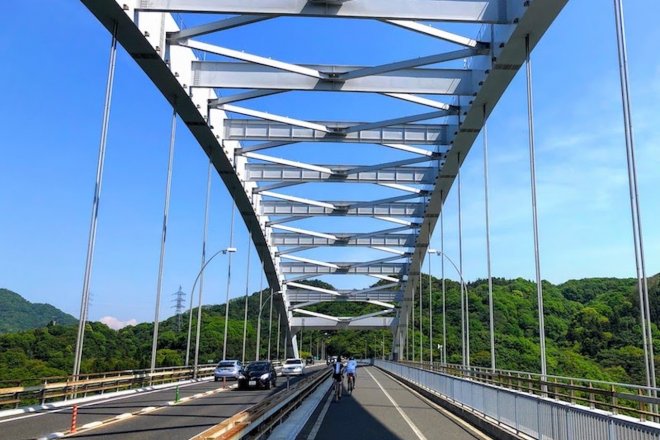
Omishima Bridge heading from Omishima to Hakatajima (Photograph: Moyuru Matsuda)
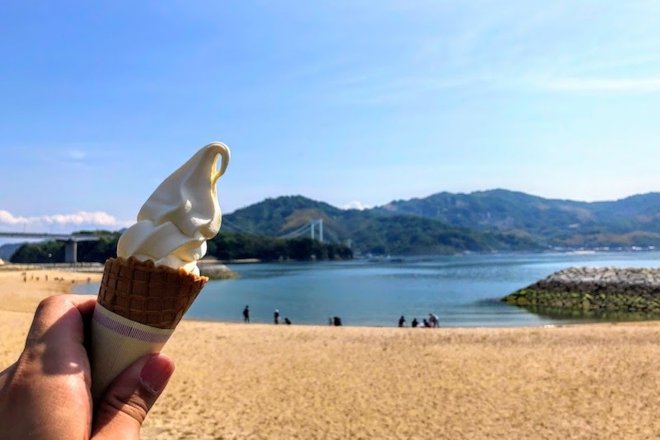
Salt-flavored soft-serve ice cream enjoyed against an ocean backdrop is really something (Photograph: Moyuru Matsuda)
Utsunomiya: The final island is Oshima. Since the blue line runs the shortest distance along the national highway that cuts through the middle of the island, I recommend riding along the coastal road on the west side if you have the time and energy. It’s best for novices to ride the shortest distance and make it to the end, but if you’re at intermediate level, leaving the blue line is one of the ways to get the most out of the Shimanami Kaido.
This area is famous as the base of the Murakami Naval Force which controlled the Seto Inland Sea between the 14th and 16th centuries. This naval force rocketed to fame after being depicted in novel and manga versions of Murakami Kaizoku no Musume (Daughter of a Murakami Pirate). Those who are interested in this history will surely enjoy stopping by the Murakami Pirate Museum for a look.
As you near the end of the road running north to south on Oshima you’ll begin to catch a glimpse of the Kurushima Kaikyo Bridge, a massive 4 km long suspension bridge. Hopefully you’ll have enough energy left to be excited by this view. If you’re tired you’ll probably just be horrified at the thought of yet another obstacle (laughs).
However, the view from this bridge is magnificent, so please do summon up your last bit of energy and attempt it. If you happen to still have energy reserves, good options include climbing up to the Kirosan Observatory Park at the top of the mountains on the south side of Oshima and enjoying the archipelago’s beauty, or stopping in the middle of the bridge and descending to Umashima island via the bicycle-friendly elevator. Featuring hidden beaches, this island is a little-known spot, not accessible by car, from which visitors can watch the tidal currents.
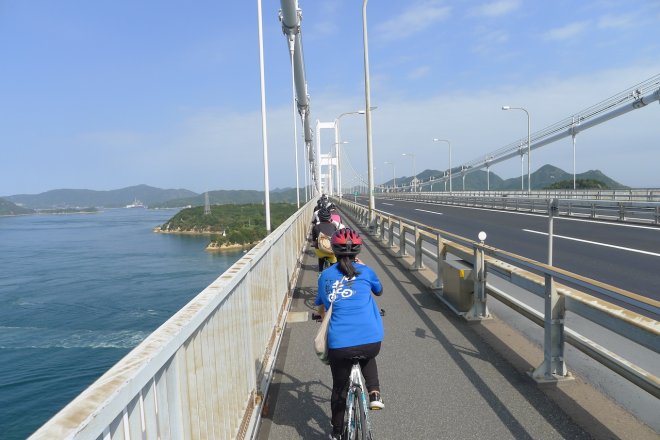
Kurushima Kaikyo Bridge
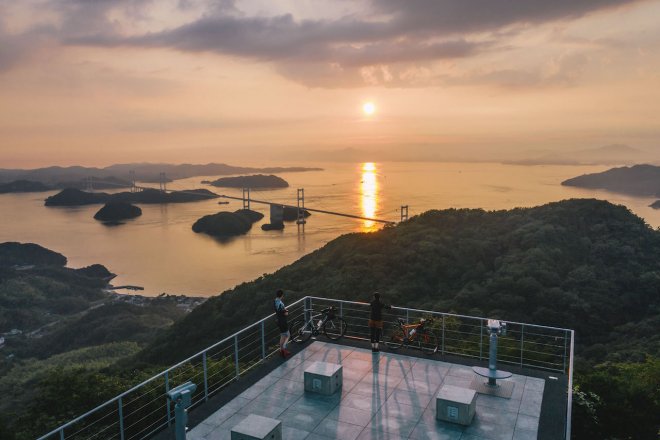
Kirosan Observatory
Contact with the locals is gold
– It really is a jam-packed ride. And finally…!
Utsunomiya: Once you’ve crossed the Kurushima Kaikyo Bridge, you arrive on the main island of Shikoku! The standard finishing point is generally held to be Cycling Terminal Sunrise Itoyama but it’s a little far from JR Imabari Station so if you return your bicycle here, travel may become tricky.
For this reason I recommend the guest house, Cyclo no Ie, located nearby Imabari Station. This base was created by a group of friends (of which I’m one) who love cycling journeys and are active in the Shimanami area. The sign out the front that says “Shimanami Kaido 0 km point” with “Start & Goal” written on it, was created at the request of travelers who wanted a commemorative photo spot that would create a sense of the elation felt at the start and the accomplishment experienced at the goal. We hope you’ll make your way towards this spot as your final goal.

Cyclo no Ie. The blue sign to the right is a popular background for commemorative photos
Utsunomiya: If you have any time left once you’ve finished crossing the Shimanami Kaido, you can make side trips to various areas in Ehime Prefecture. For example, a one-hour train ride from Imabari will take you to Dogo Onsen, believed to be the most ancient hot spring in all Japan. A further journey of one hour will take you to Uchiko Town where you can wander through streetscapes built between the second half of the 19th century and the first half of the 20th century. There is no end of things to see.
– Listening to you, I want to set off straight away! Last of all, could you tell us what appeals to you personally about the Shimanami Kaido?
Utsunomiya: As I’ve mentioned so far, the scenery is sublime, the bridges are majestic, and there are lots of local delicacies, but the greatest charm would have to be the locals’ warmth and kindness.
Over my years of guiding, I have led large numbers of bicycle tours, and it seems that, sure enough, for people who ride the Shimanami Kaido, contact with locals is what they treasure. I believe that a big part of the reason people want to come again after finishing their ride is the desire to meet up with people they met first time around.
The Shimanami Kaido is a place where locals stop to say a friendly hello, and cyclists enjoy each other’s company. Please do come and enjoy a cycling journey with its warm encounters that are unique to this place.

A tour that combines cycling and an agricultural program is among the options offered by Kazunari’s employer, CycloTourisme Shimanami.
PROFILE
Kazunari Utsunomiya
Kazunari was born in Uwa Town in Ehime’s Seiyo City in 1968. A love of cycling pushed him and his wife to embark on an unthinkable 10-year journey around the world on their tandem bicycle, visiting 88 countries. Since returning, Kazunari has been developing itineraries for Shimanami Kaido bicycle journeys as a leisure cycling guide for NPO CycloTourisme Shimanami. He spends his days combing every inch of the islands to rediscover the charms of Shimanami.
Articles you might like
Related Routes & Destinations
We use cookies on this site to enhance your user experience. If you continue to browse, you accept the use of cookies on our site. See our cookies policy for more information.





